I’m back home now, after my too-much-fun visit with friends who also happen to be California drivers (a sub-sub-species of Homo sapiens automobilius). The elections are over at last. I hope that political parties can all get along from now on but I am afraid that hope will prove to be just a pipe-dream.

While I was in San Diego we made it a point to find out when low tide was occurring so that we could spend an afternoon at the tide-pools. Along the Pacific coast are rocky reefs rich in intertidal life – here is an amazing zone extending from the highest wave-splashed rocks down to levels which are uncovered only by infrequent extreme low tides.
Reef dwellers lives are complicated each time an outgoing tide exposes them to the intensely different environments of pounding waves, drying wind, heat and UV radiation from the sun, diluted ocean salinity from rain, and a whole new set of predators. Reef dwellers are survivors, shaped by eons of evolutionary change and so able to adapt to adverse conditions. They thrive.
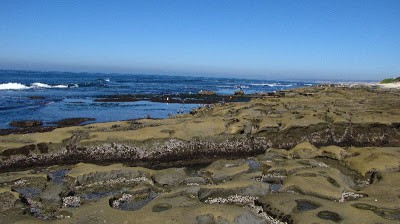
After several hours devoted to peering into the shallow shimmering pools of low tide alive with marine life, my friends and I spent the rest of the late afternoon lingering on the rocky La Jolla coastline, watching as the tide ever so perceptibly turned on its journey to once again engulf the life exposed on the rocks. As we gazed out across the blue Pacific, I posed a question – If you had a choice of where to live, would it be in the mountains or at the ocean?

My favorite tidal creatures, anemones are an animal that looks like a flower. Incredibly, they occur from the intertidal zone to 10,000 feet below sea level. Needle-like stinging cells on their tentacles inject paralyzing compounds into their prey – these stinging cells feel sticky and are usually harmless to humans. USUALLY HARMLESS??? I have been tickling anemones all these years of visiting tide pools and just now find out they are usually harmless?
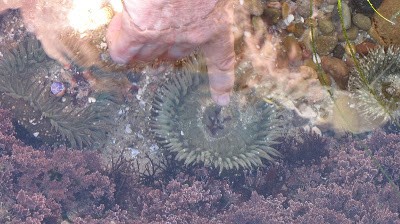
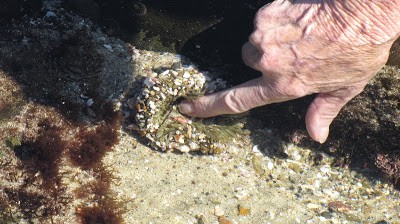
Giant green anemones – sand and shell fragments may stick to the creature making you wonder if it is in fact an anemone. So you tickle it and find out!

My intention is really not to harass wildlife.
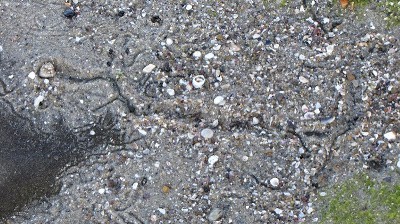
Snail trail
We didn’t see an octopus.
Boo Hoo.
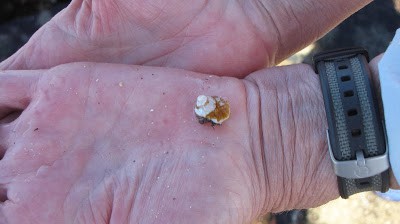
Hermit crab (Pagurus samuelis) is the type most often found in Turban and Periwinkle snail shells. Hermits are not true crabs but are more closely related to shrimps.
If the shell is empty, a hermit crab will move in. If you see the shell walking around, a hermit crab lives within its calcium carbonate environ.
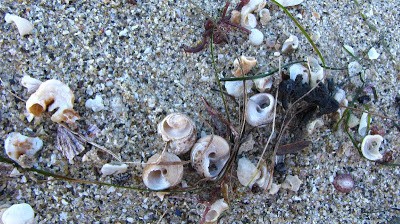
Turban shells and some other shore detritus
(scaled worm shell on left is actually the shell of a type of snail)
So what else did we see?
We identified keyhole limpets and dunce cap limpets. We saw woody or mossy chiton and lined chiton.
We saw blue California mussels in colonies. I picked up a fragment of a Purple urchin shell.
We identified communities of barnacles: volcano-shaped acorn in colonies (when underwater or a wave washing over, they reach out with feathery barbed legs to strain out plankton and absorb oxygen) found from the Aleutian Islands to Mexico; brown buckshot – tiny and abundant and also found from Alaska to San Diego; white-tipped Goose.
Cathy saw Lined Shore crabs in the high tide zone; I spotted the remnant of a purple shore crab.
We saw some small fish in pools but were unable to identify them. I discovered an amazing fact about the fish: Tide pool fish have strong homing tendencies, almost always returning to a home pool as the tide drops. Did anyone else know this?
Pink and purple algae
Pink and purple algae, sponge weed
And of course there were the birds…Brown pelican
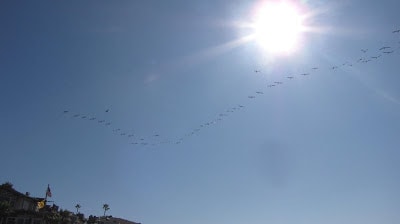
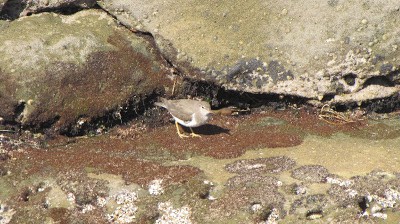

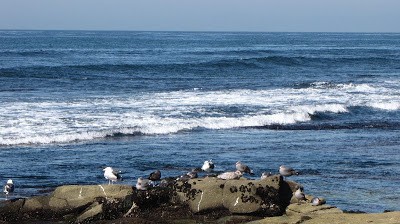
Gulls hanging out
The day just happened to be John’s birthday. What a special place to spend the afternoon with friends!









